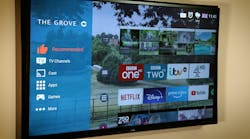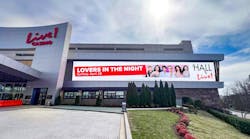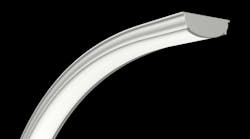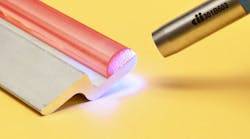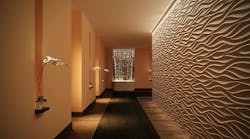Date Announced: 24 Sep 2008 The overwhelming success of the opening ceremony performance at this year’s Olympic Games surprised audience members with never-before-seen lighting and effects. LEDs, being one of the newest and greenest forms of lighting, made it all possible.[Editor's note: For more on the application of LEDs at the Olympic Games, see our article Focus on Olympic Games.]From the LED Stage Display, to the Scroll Wheels, and even to the Olympic Rings, Apcus Leyard (based out of Irvine, CA) completed their largest project to date. News media companies from across the world revered the spectacle as “breathtaking”, “magical”, and “incredible!” Audience members were very curious to know what type of material was used to create the giant scroll wheel. Was it a liquid crystal? Was it plasma? Was it a projected image?As soon as it became aware that LED technology was used, the power of the LED and its intrinsic high light output with low power consumption was made clear to the public. LEDs are now used from lighting up your dashboard gauges, to indoor lighting, to large-scale display screens. LED displays are in fact now being favored because of their many advantages such as: long life, high luminance, low energy consumption, ease of use, and etc. Public places such as gymnasiums, stadiums, squares, airports, and railway stations are incorporating LED display screens for entertainment, advertising, and crowd safety. The giant scroll wheelThe LEDs on the giant scroll wheel were evenly arranged at intervals of 20.83mm. In the whole performance, as many as ten thousand actors and performance props were incorporated which raised the issue of how to move it in and out of use. So, it was designed with a flat base surface, excellent structural strength and outstanding compression resistance.For the comprehensive requirements described above, the picture part took the form of a splice of light strips. The outer covers of the light strips were made of aluminum-magnesium alloy, a lightweight but high strength material. PC face guards were used to make the surface of the scroll wheels as well as the stage display smooth so that the performers could carry out their performance on it without hesitation. In an interview, Li Jun, Chairman of the Board of Directors of Apcus Leyard said: "This is an unprecedented challenge to the LED industry. We have succeeded in overcoming various technical and difficult problems which are hard to imagine in our design and manufacturing process."Upon seeing our display screen at the Olympic Games opening ceremony, which was considered by many to be the greatest event of the motherland in an entire century, all of the staff members of the company were incomparably excited. The entire picture scroll display will represent the most advanced level in LED display technology and unfold one hi-tech China to the whole world," said Li Jun.The rotation of the scrolls: It was an illusion; the scrolls did not really rotate, but the lifelike picture that everyone saw when the scrolls rotated and were unfolded slowly was the visual effect produced during the horizontal movement of the scroll display. Both ends of the scrolls were equipped with pulley-drawing systems separately, and by means of steel wire, drove the scrolls to move horizontally.Along the track for the pulleys to move, i.e. at the longitudinal edge of the picture, there were special-purpose floor troughs, which hid the pulleys, steel wire, etc. The moment of the picture scroll when unfolded, was pulled by steel wire in the floor troughs which drew the pulleys under the scrolls, thereby driving the scrolls to move to both ends. In addition to the rotating and rolling display picture on the scroll, one enormous magical picture scroll appeared before the audience, which captivated the attention of the entire audience and home viewers alike. Five giant Olympic ringsIn June 2007, Leyard received a large project from the Opening Ceremony's operating center to make five giant Olympic rings for this ceremony. This was a national-level secret project at that time, so the employees of Leyard had to keep this project under wraps until the start of the ceremony. Through many weeks of technical research, the development personnel of Leyard designed many different schemes, made two samples, carried out numerous tests and repeated alterations, and then finally formed the “dreamlike” Olympic Rings that enchanted everybody who witnessed them. Types of material used: The Olympic Rings Project was completed with 46794 individual LED lamps; among them were 2000 blue LEDs and 44794 white LEDs. In an interview with Mr. Chang Ming, the Lead Engineer at the Research and Development Center at Leyard, he stated: "China has looked forward to hosting the Olympic Games for 100 years. In order to represent our products in such a great event, all of us have only one faith, that is, not only finish this task, but also finish it by exceeding quality!”Obstacles to making the Olympic rings: First of all, in selecting suitable materials, it was required that the structure of the LEDs should not be seen while being used. This was a very difficult problem because generally LEDs are all welded on opaque circuit boards. Steel wire was determined to be the best way around that problem, and worked very well by providing a durable structure and also by allowing the rings to have a quasi-transparent look to them.Selecting the LEDs was also an important part of the design process. Leyard determined that using 5% blue LEDs and 95% white LEDs would make the white light appear more natural. The white LEDs also had several different color temperatures. The power supply was also an important factor to consider due to the fact that it had to be both powerful and light weight. Apcus-Leyard decided on using four lithium batteries along with a wireless remote control to operate the illumination of the LEDs. Manufacturing the Olympic Rings was also quite a challenge because the interval between any given two LED lamps rings was irregular, so it was impossible to adopt machines for welding. The Apcus-Leyard production staff hand fastened each LED one by one which was by far, the most time consuming part of the production process.On August 8, 2008, the Olympic Rings rose and the people of Apcus-Leyard witnessed their project come to fruition. It was a proud day for both Apcus-Leyard employees as well as the entire audience and most importantly it proved that imagination and innovation are and will continue to be Apcus-Leyard’s recipe for success.
Contact
Maria Crisp, APCUS Technologies
E-mail:[email protected]
Web Site:www.apcustech.com


